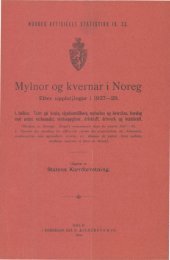Beretning om veterinærvæsenet i Norge for året 1891.
Beretning om veterinærvæsenet i Norge for året 1891.
Beretning om veterinærvæsenet i Norge for året 1891.
You also want an ePaper? Increase the reach of your titles
YUMPU automatically turns print PDFs into web optimized ePapers that Google loves.
183<br />
lions there is generally found a fibrinous covering which can be scraped off.<br />
'file mucous membrane of the bowels is red and inflamed. When death has<br />
rapidly taken place such inflamation will occasionally be found only in the<br />
st<strong>om</strong>ach and small intestines.<br />
The glands in the mesentery are swollen and dark. The spleen is<br />
apparently unchanged, oscasionally slightly swollen and soft. Very frequently<br />
there is inflamation of the lungs. In the pleura and pericardium often fibrinous<br />
exudations. on the coatings of the heart, both external and internal, there are<br />
often bloody effusions. tf the gullet and tongue be removed the above named<br />
incrustations will be more clearly seen than during life.<br />
The disease lasts, as a rule, fr<strong>om</strong> 2 to 3 days. It can however assume a<br />
lasting chronic <strong>for</strong>m, during which the animal is apparently well, and yet has<br />
large incrustations and sores in the bowels, which may be discovered when<br />
the animal is slaughtered or dies.<br />
The incubation of the virus in the body, previous to the outbreak of the<br />
disease, is, generally, fr<strong>om</strong> 2 to 8 days.<br />
The disease originates fr<strong>om</strong> a little plant which can be discerned by<br />
microscopic examination. This plant will, during the disease, be found in the<br />
stools of the animal, in its blood and most of its organs.<br />
The disease may be confounded with another malignant sickness in pigs,<br />
which is met with in this country, namely, red sickness or anthrax-like<br />
erysipelas. Animals attacked by red sickness die however much faster (in<br />
fr<strong>om</strong> half a day to 2 days), are much redder on the body and do not<br />
have any loose discharge fr<strong>om</strong> the bowels.<br />
The germs of infection of Swine fever are of very strong vitality. They<br />
are conveyed fr<strong>om</strong> the sick to healthy pigs in food, dung, bits of earth, food<br />
utensils, implements and the like.<br />
Should any ease of sickness appear in a stock of pigs, which leads to<br />
the supposition that it is Swine fever, a qualified Veterinary Surgeon must at<br />
Once be summoned, or in<strong>for</strong>mation thereof be given in towns, to the Chief<br />
C<strong>om</strong>missioner of Police, in the country to the District Head Constable. In the<br />
meantime no animal may be brought to, or removed fr<strong>om</strong> the property.<br />
The Veterinary Surgeon ought at once to dissect and carefully examine<br />
the animal if dead. Should no animal have died, a sick one ought to be<br />
slaughtered and dissected provided the owner gives his permission. Should the<br />
disease prove to be swine fever, the following rules ought to be observed.<br />
No pig may be removed fr<strong>om</strong> the property, or any new pigs be brought in.<br />
Raw portions of pigs' flesh must not be taken away. The flesh of sick or<br />
dead pigs ought not to be eaten but buried. Every person who has been in<br />
contact, with sick animals, or those suspected of being attacked, must be<br />
carefully purified. All dung must be carefully removed and buried under at<br />
least 4 feet or earth, and likewise a dead animal in its entire condition if no<br />
dissection is to be made on it. If possible lime should be strewed over it.<br />
All used litter must be burnt.

















